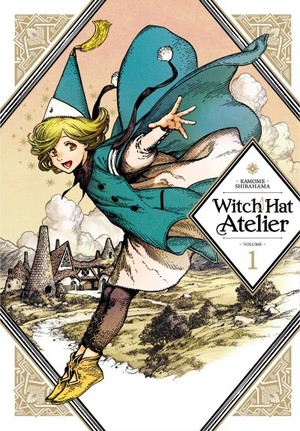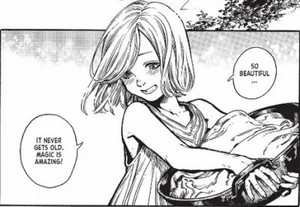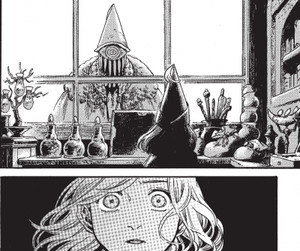The Spring 2019 Manga Guide
Witch Hat Atelier
What's It About?
 If you can be anything when you grow up, why not a witch? That's what Coco, the daughter of a seamstress in a small rural town, wants to know. Everyone insists that you have to be born into a magic family to become a witch, but Coco's sure that's not true – and when a witch stops by her family's shop and she sees him using magic, she suddenly understands that she's right.
If you can be anything when you grow up, why not a witch? That's what Coco, the daughter of a seamstress in a small rural town, wants to know. Everyone insists that you have to be born into a magic family to become a witch, but Coco's sure that's not true – and when a witch stops by her family's shop and she sees him using magic, she suddenly understands that she's right. As a tiny girl, she met a strange witch who sold her a book of spells and a magic wand, and when she sees the witch at work, she suddenly knows how to use them. Unfortunately it's a book of forbidden spells, and although he's able to save her and stop the spell, there's no going back. Instead he gets special permission for Coco to join his other students at his atelier so she can learn properly. It almost sounds too good to be true – and with her mentor having some unspoken motivations and her fellow apprentices not as welcoming as they could be, it just may be…
Witch Hat Atelier is created by Kamome Shirahama. The award-winning manga's first volume was released by Kodansha both physically and digitally on April 9th, and it sells for $10.99.
Is It Worth Reading?

Rebecca Silverman
Rating: 4.5
Did you love Little Witch Academia but think Akko was maybe a bit annoying? Then you absolutely have to pick up Witch Hat Atelier. It follows a similar premise – a young girl who has been fascinated by magic since she was tiny suddenly gets the chance to learn it despite not coming from a magical family – but Coco's world is much more traditionally fantasy-based than Akko's and she's a more measured character, albeit no less determined. Of course, Akko was just fulfilling a life-long dream; Coco's accidentally gotten her hands on a book of forbidden spells and crystalized her mother and her entire home, so she's approaching her schooling from a much darker place while being only about twelve-years-old. This first volume has a bit of the feel of an old Scandinavian fairy tale, with Coco's quest essentially being both the fulfillment of a wish and a curse.
Part of what makes this so spectacular is the care with which creator Kamome Shirahama builds the story's world. Without resorting to info-dumps, Shirahama gives us a good idea of the sort of pseudo-eighteenth or nineteenth century Europe the story is based on and simple descriptors of magic springs and clothing styles do the job of placing us firmly within the story's world. The magic system is much more fully explained, but even that is simply done without pages and pages of painful explanation – Coco has to learn these things, but her lessons feel like just that – school lessons, not extended lectures. From the basics and a couple of small explanatory statements, Coco is able to move herself forward with her studies and we can follow along with her reasoning without any difficulties. It's a beautiful example of how to do world-building right, and after a few years of reading increasingly painful attempts by what are often isekai stories to differentiate themselves and their worlds from each other, this is a real breath of fresh air.
Speaking of beautiful, the art in this book is exquisite. Each picture has lots of tiny details without feeling fussy, and even with creative panel design it's easy to read. The magic circles that form the basis of the magic system are likewise easy to make sense of, looking appropriately arcane without being over-done. The color pages in the beginning are an especial treat, with one panel of a hand drawing the panel giving us the sense of being told a story, even though we can't hear the storyteller's voice. Really, my only major issue with this is that Coco's teacher is a bit too unaware of how vicious girls that age can be, setting Coco up for some very cruel treatment at the hands of Agott, another student who is jealous of his apparent favor for Coco. Apparently there's no teacher training required before you take on apprentices in this world.
That aside, this really is a good book. Beautifully illustrated, well-told, and very interesting, it's easy to see why it's an award-winner and is worth putting on your shelves.

Faye Hopper
Rating: 4
Witch Hat Atelier is the good kind of whimsical, where imagination and affection ooze like sweet nectar out of every pore and lift you up on a warm cloud of pleasant feelings. In some ways, it's conventional, and owes a debt to both Harry Potter and Little Witch Academia, but to reduce it to just its inspirations would be selling it short. From the absolutely incredible artwork to its spellbinding, thorough worldbuilding (the magic system, the structure and way of social operation, all the various magic items are incredibly unique and inventive), Atelier has all the makings of a breakout, crossover hit.
I do have to question some of the ethical framing, however. In the world of the manga, magic that alters human physiology or manipulates mind is outlawed. This includes things like love spells and weaponized magic, but also healing magic and teleportation. Magic is described as a means to help people, and yet these key aspects that could make life a lot easier are outlawed in tandem with, like, the equivalent of H-Bombs, all under the justification of ‘protecting the world’. Add this onto how who gets to perform magic is embedded in hierarchy (with it being assumed amongst the general populace that spells can only be cast by those with ‘the gift’, creating a ruling class of wizards), and you have some potentially troubling subtext.
But this could also be deliberate. The fact that the assumed villain seems to have a sympathetic motivation (she refers to Coco as a ‘savior’) might work to undercut some of these strange assumptions. Qifrey also seems to have some animosity toward the mage circle that lives at the head of the world, which implies that the social order could be corrupt in some way. I'd be interested to see if later volumes contend with the issues of classism and resource distribution the story seems to raise. But for now, the core mysteries didn't intrigue me so much as they kept me from fully opening my heart up to Atelier. Passion and love and care flows out of every panel in Witch Hat Atelier. It's oftentimes a pure joy to read as a result; its world is inventive and unique, and yet simple enough to be easily understood, and the characters are loveable. It's the standout of the spring for a reason, and as a great all-ages read and a solid fantasy story, it's easily recommendable. I might have my reservations, but there is so much to love here.
discuss this in the forum (35 posts) |
this article has been modified since it was originally posted; see change history
back to The Spring 2019 Manga Guide
Feature homepage / archives